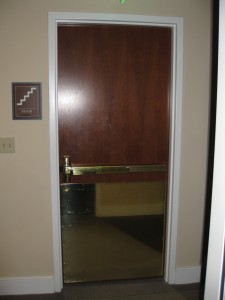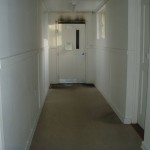 In a post about opening force a while back, I wrote that fire doors do not have to meet the opening force requirements of the accessibility codes and standards. While that IS true, someone recently asked me a question that led to this further explanation.
In a post about opening force a while back, I wrote that fire doors do not have to meet the opening force requirements of the accessibility codes and standards. While that IS true, someone recently asked me a question that led to this further explanation.
The question was regarding egress doors in a stairwell on a college campus in Massachusetts. When the fire department checked the doors while the stair was pressurized, they required more than 30 pounds to open the door.
Since the maximum opening force for a fire rated door isn’t defined by the accessibility standards, we need to check the building code. In Massachusetts we currently use the 2003 edition of the International Building Code, which limits the opening force of the doors in question to 15 pounds to release the latch, 30 pounds to set the door in motion, and 15 pounds to swing the door to the full-open position.
Here’s the text from the 2003 & 2006 IBC:
1008.1.2…The opening force for interior side-swinging doors without closers shall not exceed a five pound (22 N) force. For other side-swinging, sliding and folding doors, the door latch shall release when subjected to a 15-pound (67 N) force. The door shall be set in motion when subjected to a 30-pound (133 N) force. The door shall swing to a full-open position when subjected to a 15-pound (67 N) force. Forces shall be applied to the latch side.
The text changed slightly in the 2009 IBC:
1008.1.3 Door opening force. The force for pushing or pulling open interior swinging egress doors, other than fire doors, shall not exceed 5 pounds (22 N). For other swinging doors, as well as sliding and folding doors, the door latch shall release when subjected to a 15-pound (67 N) force. The door shall be set in motion when subjected to a 30-pound (133 N) force. The door shall swing to a full-open position when subjected to a 15-pound (67 N) force.
1008.1.3.1 Location of applied forces. Forces shall be applied to the latch side of the door.
The photo at right is the stair door in a hotel I stayed at in Williamsburg, Virginia. I’m sure some of you will point out that the protection plate is too high. That may very well be true, but as I’ve discovered lately, that’s another can of worms and I’ll cover that in a different post.
You need to login or register to bookmark/favorite this content.







I have seen kick plate or protection plates on doors in our facility that were above 16″. But, they also had UL stamping on them.
Hi Mark –
Yes – if a protection plate is installed on a fire door above the area between the floor and 16 inches up, the plate needs to have a label. Plates could be installed at the factory and would not need a label, but that changed in the 2016 edition of NFPA 80. There was no way to tell whether a plate without a label was field-installed or factory-installed, so going forward, all large plates on fire doors should have the label.
– Lori
This is a really good read for me. Must admit that you are one of the best bloggers I have ever read. Thanks for posting this informative article.